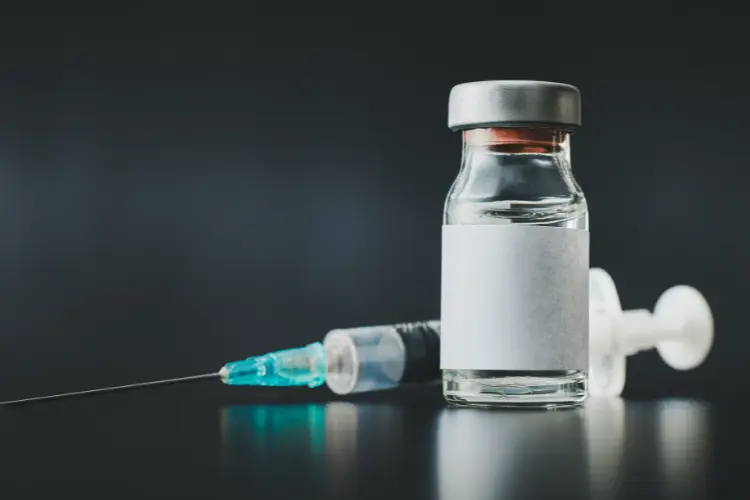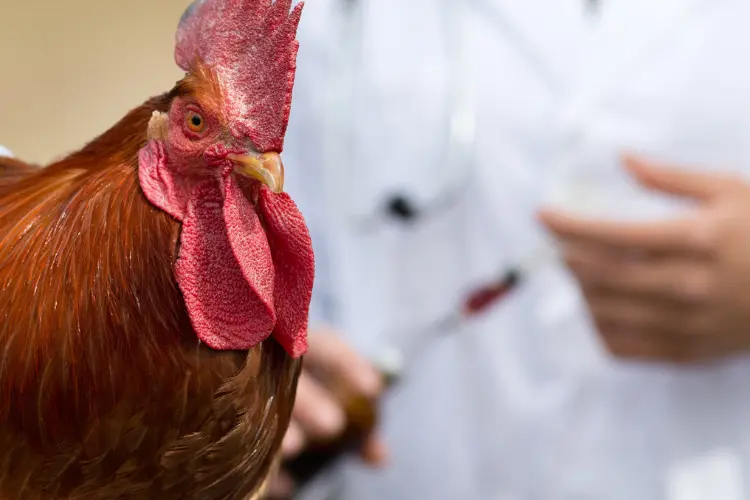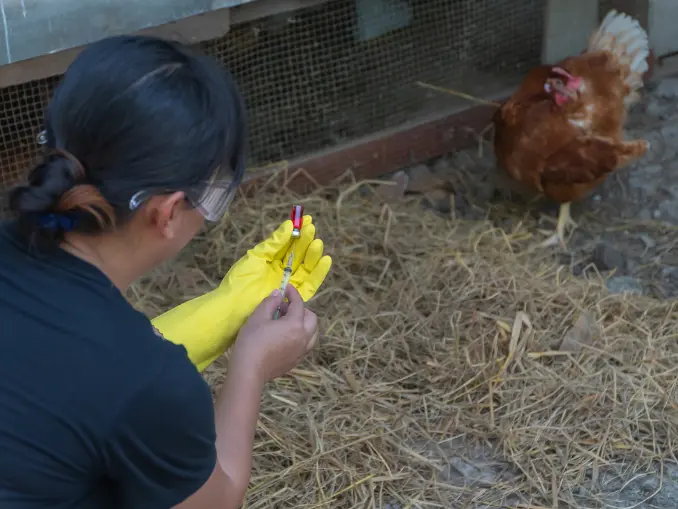Best Vaccinations for Chickens To Prevent Common Diseases
Many poultry farmers and backyard chicken enthusiasts often face the daunting task of selecting the best vaccinations for chickens to prevent common diseases in their poultry flocks. The lack of accessible and reliable information on optimal vaccination schedules, vaccine effectiveness, and potential side effects can be a significant problem in poultry management.
Without clear guidance, chicken keepers may struggle to make informed decisions, leading to suboptimal vaccination strategies that may compromise the health and well-being of their birds. Additionally, the diversity of available vaccines, each targeting specific diseases, further complicates the decision-making process.
Do I Need to Vaccinate My Chickens?
Vaccinating your chickens is not always mandatory but depends on factors like your chicken’s breed, disease prevalence in your area, and their risk of exposure. Some breeds may be more susceptible to certain diseases. If such diseases are prevalent in your region or your chickens are at high risk due to their living conditions, vaccine administration can be a valuable preventive measure.
Additionally, good biosecurity practices, like regular cleaning, providing clean feed, and minimizing contact with potentially infected birds, can complement vaccination efforts in maintaining your flock’s health.
Consult with a veterinarian or local agricultural experts to determine whether vaccination is recommended for your specific circumstances.
Read also: Organic Chicken Farming: A Guide to Sustainable Poultry
Different Chicken Vaccination Procedures

- Intramuscular Injection: This chicken vaccine is injected into the breast muscle using a hypodermic needle or automatic syringe.
- Subcutaneous Injection: Similar to intramuscular, the vaccine is injected under the skin. It’s essential to verify that the injection goes into the chicken, not just its feathers.
- Ocular (Eye) Vaccination: This involves placing the vaccine in one of the chicken’s eyes, allowing it to reach the respiratory tract via the lacrimal duct. An eyedropper is typically used.
- In-ovo Vaccination: This method administers a vaccine into the embryo before hatching. It can involve injecting the vaccine into the embryo’s body or the allantoic sac.
- Nasal Vaccination: The vaccine is introduced into the chicken’s nostrils as a dust or drop, typically using an applicator. You must ensure the correct dosage and the efficiency of the applicator.
- Oral Vaccination: This method involves administering the vaccine in the chicken’s mouth. Considerations include whether the vaccine could reach the respiratory system or continue through the digestive tract.
- Drinking Water Vaccination: The vaccine is added to the drinking water. While it’s less time-consuming and stressful for the birds, it is prone to errors, so maintaining equipment cleanliness and ensuring water quality is crucial.
- Cloacal Vaccination: This method introduces the vaccine to the cloaca mucus membranes with an abrasive applicator. This can be time-consuming and stressful for the chickens.
- Feather Follicle Vaccination: The vaccine is introduced into feather follicles using a brush. You should be careful when removing adjacent feathers and maintain proper hygiene to prevent contamination during the vaccination process.
- Wing Stab Vaccination: This method involves introducing a vaccine into the wing through a specialized needle. Avoid muscle and bone and ensure the needles penetrate the skin layers at the ideal site.
- Spray Vaccination: The vaccination process entails spraying the vaccine onto chickens through an atomizer.
Diseases in Chickens and the Proper Vaccines

Marek’s Disease Vaccine
Marek’s Disease is a contagious viral ailment primarily affecting chickens between 12 and 25 weeks of age. The Marek’s Disease vaccination is administered to day-old chicks via a subcutaneous injection on the back of the neck. It effectively prevents the development of tumors and paralysis associated with the disease.
However, it’s important to note that this vaccine does not prevent chickens from becoming infected with Marek’s virus, and they can still shed the virus to others.
Newcastle Disease Vaccine
This chicken disease is a highly contagious viral infection transmitted through the droppings and secretions of infected chickens. This vaccine is crucial for chickens and turkeys, and it comes in various forms, including drinking water, eye/nose drops, or injections.
Additionally, repeated vaccinations are essential to prevent the disease, and you may need booster shots to maintain immunity over time.
Avian Rhinotracheitis Vaccine
Avian Rhinotracheitis, also known as swollen head syndrome, affects various bird species, including chickens. The vaccine for this disease is vital for protecting your flock. It’s essential to ensure that the vaccine contains the appropriate virus serotype for your geographical area to effectively prevent the disease.
Laryngotracheitis Vaccine
Infectious Laryngotracheitis (ILT) is a contagious respiratory infection primarily affecting chickens and pheasants. The vaccine for ILT is administered through eye drops when needed, usually at around 10-12 weeks of age. It’s crucial to consider vaccination only in areas with a known ILT issue to prevent outbreaks.
Infectious Bronchitis Vaccine
Infectious Bronchitis is a viral disease causing respiratory problems in chickens. To protect your flock, a vaccine is often combined with the Newcastle disease vaccine. It is typically administered at the hatchery or between 10 and 35 days of age.
Avian Encephalomyelitis Vaccine
Avian Encephalomyelitis (AE) primarily affects young chickens and other bird species. The vaccine is administered to breeder pullets at 10-15 weeks of age via a wing web injection. Commercial live vaccines provide maternal immunity to offspring, offering comprehensive protection.
Fowl Cholera Vaccine
Fowl Cholera affects various bird species, including chickens and turkeys. Two types of vaccines are available – live attenuated viruses and inactivated bacterins. The choice of vaccine depends on your specific circumstances.
The live vaccine is done orally, while the inactivated vaccine requires a series of two injections given at 4-week intervals. Vaccination is recommended only if fowl cholera is prevalent in your area.
Infectious Bursal Disease Vaccine
This infection is a highly contagious viral ailment affecting young chickens. To prevent the disease, you should vaccinate chicks between 14 and 21 days old via drinking water.
Fowl Pox Vaccine
Fowl Pox is a viral infection causing skin lesions in chickens. Mosquitoes often spread it. This chicken vaccine is administered in the wing web at 10-12 weeks of age and is recommended, especially in areas with a history of outbreaks. This vaccine for chickens exposes them to a mild form of the active virus to build immunity while avoiding complications.
Types of Vaccination for Chickens

Vaccines can be classified into different types based on their composition and how they are prepared. These three types – live vaccine, attenuated vaccine, and killed vaccine – fall under the broader categories of viral and bacterial vaccines. Here’s a bit more detail on each:
Live Vaccine (or Live Attenuated Vaccine)
Live vaccines utilize a modified yet viable form of the virus or bacterium responsible for a specific disease. Through careful alteration, the organism loses its ability to induce severe illness in the vaccinated individual.
Moreover, the primary function of live vaccines is to trigger a robust immune response, often resulting in enduring immunity. By closely resembling a natural infection, these vaccines prompt the production of antibodies and memory cells so the chicken’s body can recognize and combat the pathogen.
An example of a live vaccine is the Measles, Mumps, and Rubella (MMR) vaccine, which has effectively prevented these contagious diseases by mimicking the immune system’s response to natural infections.
Attenuated Vaccine
Resembling live vaccines employ a weakened version of the pathogen, with the attenuation process potentially incorporating genetic modifications or laboratory procedures to reduce virulence.
Despite potentially causing a mild or asymptomatic infection, these vaccines effectively stimulate an immune response, offering protection against the complete manifestation of the disease. An instance of an attenuated vaccine is the Oral Polio Vaccine (OPV).
Killed Vaccine (Inactivated Vaccine)
Killed vaccines, also known as inactivated ones, render the virus or bacterium inactive through heat, chemicals, or radiation. The inactivated pathogen loses its ability to replicate or induce disease, ensuring a safe immunization process.
While the immune response triggered by killed vaccines may be slightly less robust than live or attenuated vaccines, they remain effective in promoting the production of antibodies and memory cells.
An illustrative example of a killed vaccine is the Hepatitis A vaccine, exemplifying the utilization of this approach to confer immunity against the targeted disease.
Tips for a Successful Vaccination for Chickens

- Adhere to the recommended vaccination schedules provided by poultry health authorities or veterinarians.
- Check that the vaccine has been transported and stored correctly. Keep it in a chilled or frozen state, as prolonged exposure to higher temperatures can lead to a loss of potency.
- Before use, verify that you have received the correct type and quantity of vaccine as per your order.
- Always check the expiry date of the vaccine. Most vaccines lose effectiveness, so use them within the recommended timeframe. The expiry date is based on proper storage conditions.
- Place vaccines into recommended storage conditions immediately. Different vaccines may have specific temperature requirements, so read and follow the instructions carefully. For example, you should store freeze-dried vaccines below freezing, while their diluent should be slightly above freezing. Liquid vaccines are typically stored just above freezing.
- Only remove and reconstitute enough vaccines for immediate use. Do not pre-mix the vaccine for the entire day, as it may rapidly lose its efficacy.
- After mixing vaccines, place them in an ice bath to maintain their potency. Some vaccines have a short life once mixed, and keeping them in an ice bath can extend their effectiveness.
- Follow the recommended administration techniques for each vaccine type. Do not deviate from these methods without veterinary advice.
- Always clean and sterilize vaccinating equipment thoroughly after use to prevent contamination.
- Properly dispose of unused mixed vaccines after completing the vaccination task. Some vaccines can be harmful if not destroyed correctly.
- Do not vaccinate sick birds already showing signs of disease or stress. Vaccination may not be effective in such cases and could worsen their condition.
What Vaccine Is Best for Broiler Hens?
For broiler hens, the choice of vaccines should be based on the prevalent diseases in your region and the specific health risks associated with broiler production. Common vaccines for broiler hens include those targeting Infectious Bronchitis (IB) and Newcastle Disease (ND), which are crucial for respiratory health and overall flock performance. Additionally, you might also consider vaccines to prevent diseases like Marek’s Disease and Avian Influenza (AI) depending on the local disease landscape and biosecurity measures.
What Vaccine Is Best for Chicks and Older Chickens?
The ideal vaccine for older chickens depends on various factors, including their current health status, the diseases in your area, and their previous vaccination history.
Typically, chickens are vaccinated against diseases like Marek’s disease, Newcastle disease, and Infectious Bronchitis at a young age. For older chickens, you might consider booster shots, especially if they are at risk of exposure to these diseases.
However, it’s essential to consult with a veterinarian or a poultry health expert. They can provide specific vaccination programs based on the local disease prevalence and the specific needs of your flock. Additionally, good management practices and biosecurity measures are crucial in preventing diseases in older chickens.
Read also:10 Must-Have Baby Chick Raising Supplies: A Complete List
Preventing Diseases Through Chicken Vaccinations
Vaccinating chickens is an essential practice for safeguarding their health and preventing the spread of common avian diseases. However, consult with veterinarians to determine the most appropriate vaccination schedule and protocols, considering factors such as the specific risks in their region, the type of poultry, and the birds’ age.
By adhering to a comprehensive vaccination program, you can effectively reduce the incidence of disease, enhance the welfare of your backyard poultry, and contribute to a more resilient and healthy food supply chain.




